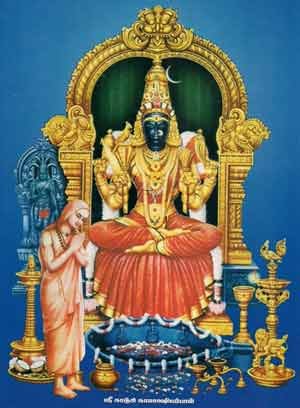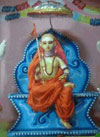Adi Shankaracharya & His Connection with Kanchipuram
A book By Sri A. Kuppuswami, B.A., B.T.
|
SRI SHANKARACHARYA AND HIS CONNECTION WITH KANCHIPURAM |
|

|
CHAPTER-1
Sri Sankara's Digvijaya Yatra Bhaskaracharya the celebrated commentator of the Lalitasahasranama (the one thousand names of Lalita Devi), in his preface to his commentary, pours forth his tribute to Sri Sankara Bhagavatpada, in a verse in which he cites the explanation for the Rg Veda mantra, ‘Dhenumpahvayami sidhugham’, found in an ancient work by name ‘Vishnjudharmottara’. This work is a puranic treatise containing the teachings of a great Yaksha, by name Pushkara, to Sri Rama. Bhaskaracharya’s verse runs thus: |
 In the above verse it is stated that “in the course of the explanation of the contents of the three Vedas by the great Yaksha, named Pushkara, to Sri Rama specially narrated in the ‘Vishnudharmottara’, the meaning of the Rg (mantra) – ‘Etam Sankaracarya. I bow unto that preceptor of preceptors, Sankaracarya, with his four disciples.” References to Sankaracarya as an incarnation of Siva, Surya etc., are seen in some of the puranas and some other ancient works. Perhaps the earliest of references to Sankara (or to one of his illustrious successors bearing his name), by foreigners, is to be found in an inscription of a king of Cambodia of the 9th century A.D. This inscription in Cambodia speaks of the king having undergone study of the Sastras under Sankara, an all-knowing person. The verse in the inscription is as follows:-
Sri Sankara was born at Kaladi near Tiruchivapperur (modern Tiruchur), in Kerala to Sivaguru and Aryamba. A few years after his birth, Sankara lost his father. Sankara took to the study of the Veda, after having been initiated into brahmacharya(batcherlorhood). The young boy showed marks of a genius. One day he was bathing in the river nearby. A crocodile caught one of his feet and began to drag him deep into the river. Knowing that the only way open for escaping from the danger was by turning an ascetic, Sankara quickly uttered the mantras and did in short the necessary things for getting into the sannyasasrama. The crocodile too left his foot. The young ascetic’s strong resolve was approved by his aged mother, though reluctantly, for she desired her only son should be alive at any cost. Ramabhadra Deekshita, an erudite scholar, presents a succinct sketch of Sankara’s life-story in his kavya, ‘Patanjali Caritam’. The scholar begins the story in the eighth canto of his work, with this incident of the crocodile’s catching the foot of Sankara:-
The verse says that his food having been caught by a crocodile, in the river, the sage Sankara took to the ascetic order and got freed quickly from the clutches of the crocodile. Then Sankara arranged for his mother being taken care of properly, and with her consent left Kaladi. He began to travel northwards for being formally initiated in the sannyasa ashrama, by a good preceptor. In course of time he reached the bank of the Narmada river. According to tradition and most literary evidences, the boy ascetic got formally initiated by Govinda Bhagavatpada who was residing in a small cave on the bank of the Narmada. According to a verse in the Sankara-vijaya, authorship of which is ascribed to Madhava Govinda Bhagavatpada initiated Sankara by imparting all the mahavakyas to him. The verse is as follows:
Chidvilasa’s biography of /Sankaracharya also notes that Sankara was initiated into all the mahavakyas by Govinda Bhagavatpada, thus:-  (“Mahavakyani divyani tattvamasyadikanyapi; Mumuksubhih sada dhyeyam rahasyam yadyadasti tat. Upadisadatah sarvam vedantartha viniscitam; Sanyasibhirvidheyamstu visvesassmrticoditan.’) The several biographies dealing with the life-story of Sankara and other works giving brief sketches as well are not completely uniform in details. But still all these works indicate Sankara’s long and extensive tour, on foot, through the length and breadth of the country (perhaps even twice), for the purposes of condemning heretic religious sects, of safeguarding the Vedic Dharma, of establishing the six- fold path of devotion on a sound Vedic base and for the propagation of Advaita Vedanta. It is no wonder that many a holy spot in the country claims some kind of association or other with the name of Adi Shankaracarya. Most biographical works on Sankara and other works having some incidental information about the great Acarya uniformly narrate Sankara’s covering the four dhams or the traditional four Corners of India – Dvarka in the west, Badrinath in the north, Jagannath Puri in the east and Ramesvaram in the south – during the course of his digvijaya or tour of the victory of the directions. Moreover the three popular biographies of Sankara viz, the Sankaravijaya ascribed to Madhava, (Navakalidasa) Cidvilasa’s biography and Anandagiri’s work agree in the Acarya’s visits to four of the seven sacred mokshapuris – Kasi, Kanchi, Ujjain and Dvaraka. His visits to Ayodhya, Maya (Hardvar) and Madhura are not ruled out.
|
|
| Book Index Page |  |
Next:Sri Sankara's Digvijaya Yatra - Sankaracarya at Varanasi |
Back to Page - Focus Adi Shankaracharya


